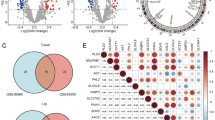Abstract
Patients with coronavirus disease 2019 (COVID-19) might cause long-term burden of insomnia, while the common pathogenic mechanisms are not elucidated. The gene expression profiles of COVID-19 patients and healthy controls were retrieved from the GEO database, while gene set related with circadian rhythm was obtained from GeneCards database. Seventy-six shared genes were screened and mainly enriched in cell cycle, cell division, and cell proliferation, and 6 hub genes were found out including CCNA2, CCNB1, CDK1, CHEK1, MKI67, and TOP2A, with positive correlation to plasma cells. In the TF-gene regulatory network, NFYA, NFIC, MEF2A, and FOXC1 showed high connectivity with hub genes. This study identified six hub genes and might provide new insights into pathogenic mechanisms and novel clinical management strategies.

Similar content being viewed by others
Data availability
The datasets analyzed (GSE217948) during this study are publicly available in the GEO database (https://www.ncbi.nlm.nih.gov/geo/), the original contributions presented in this study are included in the article/supplementary material, and further inquiries can be directed to the corresponding author.
References
Alhamid G, Tombuloglu H, Motabagani D, Motabagani D, Rabaan AA, Unver K, Dorado G, Al-Suhaimi E, Unver T (2022) Colorimetric and fluorometric reverse transcription loop-mediated isothermal amplification (RT-LAMP) assay for diagnosis of SARS-CoV-2. Funct Integr Genom 22(6):1391–1401
Carfì A, Bernabei R, Landi F (2020) Persistent symptoms in patients after acute COVID-19. Jama 324(6):603–605
Ford ES, Wheaton AG, Cunningham TJ, Giles WH, Chapman DP, Croft JB (2014) Trends in outpatient visits for insomnia, sleep apnea, and prescriptions for sleep medications among US adults: findings from the national ambulatory medical care survey 1999-2010. Sleep 37(8):1283–1293
Jansen PR, Watanabe K, Stringer S, Skene N, Bryois J, Hammerschlag AR, de Leeuw CA, Benjamins JS, Muñoz-Manchado AB, Nagel M, Savage JE, Tiemeier H, White T, Tung JY, Hinds DA, Vacic V, Wang X, Sullivan PF, van der Sluis S et al (2019) Genome-wide analysis of insomnia in 1,331,010 individuals identifies new risk loci and functional pathways. Nat Genet 51(3):394–403
Matsuo T, Yamaguchi S, Mitsui S, Emi A, Shimoda F, Okamura H (2003) Control mechanism of the circadian clock for timing of cell division in vivo. Science 302(5643):255–259
Mousavi SZ, Rahmanian M, Sami A (2022) Organ-specific or personalized treatment for COVID-19: rationale, evidence, and potential candidates. Funct Integr Genom 22(3):429–433
Pappa S, Ntella V, Giannakas T, Giannakoulis VG, Papoutsi E, Katsaounou P (2020) Prevalence of depression, anxiety, and insomnia among healthcare workers during the COVID-19 pandemic: a systematic review and meta-analysis. Brain Behav Immun 88:901–907
Stein MB, McCarthy MJ, Chen CY, Jain S, Gelernter J, He F, Heeringa SG, Kessler RC, Nock MK, Ripke S, Sun X, Wynn GH, Smoller JW, Ursano RJ (2018) Genome-wide analysis of insomnia disorder. Mol Psychiatry 23(11):2238–2250
Stokes EK, Zambrano LD, Anderson KN, Marder EP, Raz KM, El Burai Felix S, Tie Y, Fullerton KE (2020) Coronavirus disease 2019 case surveillance - United States, January 22-May 30, 2020. MMWR Morb Mortal Wkly Rep 69(24):759–765
Wong AW, Shah AS, Johnston JC, Carlsten C, Ryerson CJ (2020) Patient-reported outcome measures after COVID-19: a prospective cohort study. Eur Respir J 56(5)
Acknowledgements
We gratefully acknowledge the contributions from the Department of Nuclear Medicine, Beijing Friendship Hospital, Capital Medical University, GEO databases, and Genecards.
Funding
This research was supported by the National Natural Science Foundation of China (No: 82272034, 82102088) and the Capital’s Funds for Health Improvement and Research (No: 2020-2-2025).
Author information
Authors and Affiliations
Contributions
Yanfeng Xu: Conceptualization, Methodology, Data curation, Software, Validation, Formal analysis, Visualization, Writing–original draft, Writing–review and editing.
Mingyu Zhang: Methodology, Writing-review and editing.
Guanyun Wang: Formal analysis, Data curation, Writing–review and editing.
Jigang Yang: Conceptualization, Funding acquisition, Project administration, Supervision, Writing–review and editing.
Corresponding author
Ethics declarations
Ethics approval and consent to participate
Not applicable.
Consent for publication
Not applicable.
Competing interests
The authors declare no competing interests.
Additional information
Publisher’s note
Springer Nature remains neutral with regard to jurisdictional claims in published maps and institutional affiliations.
Supplementary information
ESM 1
Figure S1. Construction of co-expressed gene networks in dataset GSE217498. (A) Selection of soft threshold powers. (B) The constructed co-expression modules of COVID-19 related genes by WGCNA. (C) Module-trait association. Each row corresponded to a module feature, and each cell contained the correlation and the corresponding P value. (JPG 5483 kb)
ESM 2
Figure S2. (A) The correlation heat map of six hub genes. The area size and the color of circles represent the strength of the correlation between genes. (B) The heat map of six hub genes. Red represents high expression and blue represents low expression. (JPG 5316 kb)
ESM 3
Figure S3. (A-F) Bar plot of 6 identified hub genes in GSE217948. (G-L) Bar plot of 6 identified hub genes in GSE166253. ***: P < 0.001, *: P < 0.05, NS: P > 0.05. (JPG 8061 kb)
Rights and permissions
Springer Nature or its licensor (e.g. a society or other partner) holds exclusive rights to this article under a publishing agreement with the author(s) or other rightsholder(s); author self-archiving of the accepted manuscript version of this article is solely governed by the terms of such publishing agreement and applicable law.
About this article
Cite this article
Xu, Y., Zhang, M., Wang, G. et al. Identification of six genes associated with COVID-19-related circadian rhythm dysfunction by integrated bioinformatic analysis. Funct Integr Genomics 23, 282 (2023). https://doi.org/10.1007/s10142-023-01198-7
Received:
Revised:
Accepted:
Published:
DOI: https://doi.org/10.1007/s10142-023-01198-7




